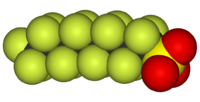
Photo from wikipedia
Abstract The accidental or malicious release of toxic substances in the urban atmosphere is a major environmental and safety problem, especially in large cities. Computational fluid dynamics codes and simplified… Click to show full abstract
Abstract The accidental or malicious release of toxic substances in the urban atmosphere is a major environmental and safety problem, especially in large cities. Computational fluid dynamics codes and simplified modelling tools have been used in the last decades to model pollutant dispersion in urban areas. These studies have shown that propagation is strongly influenced by the layout of buildings and, therefore, by the street topology of the city. This work presents a novel approach to the study of toxic propagation within the urban canopy based on the theory of complex networks. The urban canopy is modelled as a network, where the streets and the street intersections represent respectively the links and the nodes of the network. The direction and the weights of the links contain the geometrical characteristics of the street canyons and their wind conditions, so that all the key variables involved in pollutant dispersion are represented in a single mathematical structure that is a weighted and directed complex network. Thanks to this mathematical interpretation, propagation is modelled as a spreading process on a network and a depth-first search algorithm is used to rapidly delimit the zone of influence of a source node. This zone is the set of streets that are contaminated from the source. As a case study, the proposed model is applied to the urban tissue of the city of Lyon. The algorithm simulates a toxic release in all the nodes of the network and computes the number of people affected by each propagation process. In this way, the nodes with the most dangerous spreading potential are identified and vulnerability maps of the city are constructed. Moreover, various wind and concentration scenarios are easily implemented. The results highlight how the proposed method is effective in assessing the most vulnerable points in a city with a computational time that is up to three orders of magnitude lower than that of existing models. Moreover, the proposed approach paves the way to future applications of tools and metrics from the complex network theory for a deeper comprehension of the mechanisms that drive pollutant dispersion in urban areas.
Journal Title: Atmospheric Environment
Year Published: 2019
Link to full text (if available)
Share on Social Media: Sign Up to like & get
recommendations!